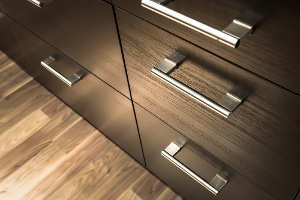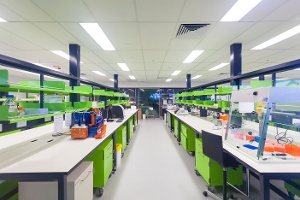When it comes to testing expensive electronics, accuracy and safety are very important. Where testing takes place can impact both of these.
A test bench is a lab bench designed specifically to test the functionality and soundness of products, usually electronics.
Because electronics are sensitive to environmental changes around them, a lab test bench must meet certain specifications to ensure the bench doesn't interfere with the testing itself and promotes ease of use for the tester technician.
Having the right lab test bench design can ensure technician safety, create a productive workplace and improve the accuracy of this important work. If it’s time to replace your worn-out or outdated lab test bench, here’s how to design the best one for your workspace.
Ensure ESD Protection
Because lab test benches are often used during the testing of electronics, the bench should offer ESD protection. ESD (electro-static discharge) protection guards sensitive electronic components against static.
When combined with ESD workwear, special handling techniques, ESD chairs and other safeguards, a lab test bench with ESD protections in place ensures electricity doesn't interfere with testing, or worse, cause memory or corruption failures.
In extreme situations, discharges can ignite flammable liquids and vapors. They can also attract unwanted particles from around the room, which can pose a significant problem for labs with cleanliness requirements.
ESD laminate surfaces are by far your best way to design a lab bench that doesn't promote static. As a bonus, ESD laminate is also resistant to heat and solvents. So if you're worried about how they hold up to soldering and harsh cleaning, the answer is very well.
ESD laminate will cost more than standard laminate and other countertop surfaces. Expect to pay about 15% to 30% more for an ESD product over a non-ESD product. However, the extra cost may be necessary to preserve the integrity of your lab.
Storage For Tools
Hunting for tools can be a massive productivity killer. The best lab test benches are designed with the user in mind. They have room for tools large and small, from oscilloscopes to multimeters, soldering irons, wire cutters, voltmeters, ohmmeters and ammeters.
have room for tools large and small, from oscilloscopes to multimeters, soldering irons, wire cutters, voltmeters, ohmmeters and ammeters.
An excellent lab bench will also have plenty of organizational options as well, ensuring that it is easy to stay focused and tools are within reach.
One of the biggest mistakes lab managers make when choosing lab benches is overlooking sufficient storage space. They either underestimate the room needed for testing tools or create shared tool cabinets. This never works out well when you have multiple techs always needing the same equipment.
Don't skimp on this critical design feature. Storage generally includes a combination of:
- Open shelving
- Closable cabinets
- Power supply strips
- Ability to achieve good lighting from every angle
- Drawers
- Pegboards for awkwardly-shaped tools
- Keyboard trays
- Bin rails for sorting components
Every tester will have their own "best way" to organize their testing station to maximize productivity. These types of storage features set them up for success.
Utility Options And Access To Power Supply
For a lab test bench, you’ll want to make sure you have utility options available to you. Some common features include utility ductways for data and LED lighting that provides the needed illumination when working with electronics.
Also, someone using a lab test bench may need a source of DC power nearby so that they can test circuits under a variety of conditions.
Wonder why these kinds of details are important? Let's take a closer look at the power supply setup.
When you place a lab test bench directly over the outlet, then run the cord up through the hole in the lab bench, you prevent tripping hazards and fire risk. Make-shift outlet solutions are never a good idea with expensive electronics and test equipment involved.
Similarly, if the tester has to plug/unplug different tools throughout the test process, you want a lab bench with a powerstrip on the top-back or side. This way, they don't have to crawl up under the bench to establish or cut power … wasting time and putting them at risk of injury.
Ergonomic Design
Ergonomics is the science of creating an environment that promotes employee productivity on an individual level. When a work environment promotes comfort, reduces strain, encourages natural movement and shows that employers care about employee wellness, people are more productive.
work environment promotes comfort, reduces strain, encourages natural movement and shows that employers care about employee wellness, people are more productive.
An ergonomic workstation:
- Lessens muscle fatigue
- Reduces repetitive actions that lead to musculoskeletal injuries like carpal tunnel, rotator cuff inflammation, tendonitis, or tennis elbow
- Promotes a safe and supportive work environment
- Reduces eye strain
- Reduces adjustment time (e.g., chairs, trays, lighting, and other moving parts don't have to be constantly manipulated for use and comfort. If they are adjustable, adjustment is fast and easy.)
- Encourages an easy shift between sitting and standing
Employers both have the responsibility and power of prevention when it comes to work-related injuries. According to the Bureau of Labor Statistics, 30% of worker injuries and illnesses are musculoskeletal disorders. These numbers have been on the decline over the past 10 years thanks to increased ergonomics awareness.
The Best Lab Test Bench Design Starts With You
An ergonomically-friendly lab bench is versatile. It allows each worker to find his or her own best working positions rather than forcing an uncomfortable cookie-cutter layout for everyone.
The best lab benches also protect technicians and costly electronics. They provide a variety of customizable storage solutions to allow testers autonomy when it comes to the best setup for them.
Your bench and other lab furniture should be ergonomically-friendly and promote comfort, productivity and wellness. It should be versatile enough that testers of all heights, sizes, abilities and sit-stand preferences can use it effortlessly.
The best lab bench manufacturers will accommodate your specifications without holding up your project. They'll be there to answer any questions you have, so you feel confident about your lab bench material, cost, features and protection choices.


